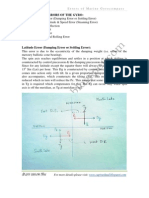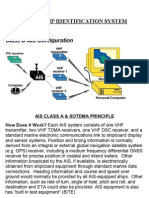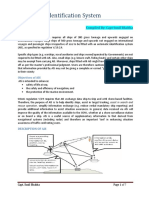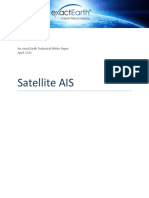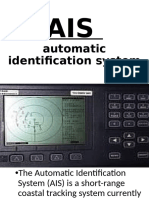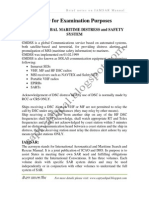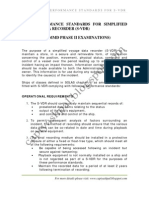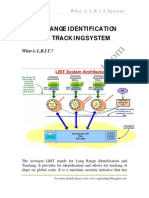P A G e H o W A I S W o R K S ?
P A G e H o W A I S W o R K S ?
Uploaded by
atinder13Copyright:
Available Formats
P A G e H o W A I S W o R K S ?
P A G e H o W A I S W o R K S ?
Uploaded by
atinder13Original Description:
Original Title
Copyright
Available Formats
Share this document
Did you find this document useful?
Is this content inappropriate?
Copyright:
Available Formats
P A G e H o W A I S W o R K S ?
P A G e H o W A I S W o R K S ?
Uploaded by
atinder13Copyright:
Available Formats
1|Page WHAT IS AIS?
How AIS works?
We all are familiar with the desperation and urgency, when we tried to establish the identification of a vessel, by calling her on VHF something like this; calling the vessel on my starboard side, approaching from North, having hull of blue colour and funnel of yellow colour etc. etc. In open seas, with not too much traffic, and daylight the exercise normally did not fail the OOW. But the problem arose in dark hours and much so in heavy traffic, when the situation was fraught with the risks of misidentification. This was one very troublesome weak link in the chain of communication and identification. AIS (Automatic Identification System) aims to replace the weak link and provide the OOW with automatic and positive identification of targets fitted with AIS, in addition to other relevant information. It sends own ships identification and similar information, likewise to other targets and shore stations. Operating in the VHF maritime frequency band, it acts like a transponder and uses, without any human intervention, voiceless electronic communication to broadcast and receive the required data and messages.
PRINCIPLE:
For more details please visit: www.captyashpal.blogspot.com
2|Page
How AIS works?
We have heard of cell phone technology, known as CDMA (Code Division Multiple Access). AIS works on principle of similar technique, with a different name, and in VHF maritime band. It is known as SOTDMA and stands for Self Organizing Time Division Multiple Access. The technique: Is fully automatic and works without involvement of human intervention. It does not suffer from problems of mutual interference and resolves conflicts, if any, on its own It is thus, Self Organizing. Divides a unit of one minute of time into number of (minimum to be 2000, as per IMO) slots or time schedules. Accurate time signals from GPS are utilized for this purpose. Considering 2000 slots, spread over a time frame of one minute or 60 seconds, each slot will measure 30 milliseconds. These slots or time schedules are like turns for several targets to transmit their data. Hence the expression Time Division Allows for large number of transmissions to be accommodated over a single narrow band VHF radio channel. This is done by synchronizing the transmissions to the highly accurate time slots with the help of GPS time signal. Multiple slots, thus allow Multiple Access.
OPERATION: Each AIS system consists of following components: One VHF transmitter Two VHF TDMA receivers, receiving data on two VHF channels: AIS 1- 161.975 MHz (87B) and AIS 2- 162.025 MHz (88B) One VHF DSC Channel 70 receiver A standard marine electronic communications link to shipboard display and sensor systems. Position and timing information is normally derived from an integral or external global navigation satellite system (e.g. GPS) receiver, including a medium frequency differential GNSS receiver for precise position in coastal and inland waters. Other information broadcast by the AIS, if available, is electronically obtained from shipboard equipment through standard marine data connections. Heading information and course and speed over ground would normally be provided by all AIS-equipped ships. Other information, such as rate of turn, angle of heel, pitch and roll, and destination and ETA could also be provided. AIS equipment is also has built in test equipment (BITE) AIS is provided with a pilot plug for connecting the PPU (Personal Pilot Unit).
For more details please visit: www.captyashpal.blogspot.com
3|Page Ae
How AIS works?
VHF Transmitter VHF Receiver AIS 1 161.975 MHz VHF Receiver AIS 2 Hh 162.025 VHF Receiver DSC Channel GPS Receiver BITE
Hdg.
Sensors Interface
VHF Interface
ROT
Ae
Posn. Spd.
CPU and
ECDIS Overlay (Optional) Radar Overlay (Optional)
Pilot Port
MKD
Simplified Diagram of AIS (Captain Yashpal Singh)
AIS consists of both hardware (mobile station itself, GPS Antenna and VHF Antenna) and software. Software can be reinstalled or upgraded to the latest version in the field by running a software installation procedure. Position and other data are fed automatically from the ships sensors into the AIS system, where the data is formatted and transmitted in a short data burst on a dedicated VHF channel. When received on the other ships, the data is decoded and displayed for the officer of the watch, who can view AIS reports from all other AIS-equipped ships within range in graphic and text format. The AIS data may optionally be fed to the ships integrated navigation systems and Radar plotting systems to provide AIS tags for Radar targets. The AIS data can also be logged to the ships Voyage Data Recorder (VDR) for playback and future analysis.
For more details please visit: www.captyashpal.blogspot.com
4|Page
How AIS works?
The area in which AIS messages can be received is called ships cell.(Ashore, a repeater can be used to increase the coverage of a cell).Each ship in this way is at the centre of its own communication cell. If the AIS messages begin to overload the network, it automatically shrinks its cell by ignoring weaker stations further away in favour of those nearby. Although only one radio channel is necessary, each station transmits and receives over two radio channels to avoid interference problems, and to allow channels to be shifted without communications loss from other ships. Each station determines its own transmission schedule (slot), based upon data link traffic history and knowledge of future actions by other stations. Slot selection by an AIS station is randomized within a defined interval, and tagged with a random timeout of between 0 and 8 frames. When a station changes its slot assignment, it pre-announces both the new location and the timeout for that location. In this way new station, including those stations which suddenly come within radio range close to other vessels will always be received by those vessels. AIS must transmit DTM (datum reference sentence) immediately prior to every positional sentence which is reflected to a datum other than WGS 84, the datum recommended by IMO.
. OPERATION OF AIS ON BOARD OPERATION OF THE TRANSCEIVER UNIT AIS should always be in operation when ships are underway or at anchor. If the master believes that the continual operation of AIS might compromise the safety or security of his/her ship, the AIS may be switched off. This might be the case in sea areas where pirates and armed robbers are known to operate. Actions of this nature should always be recorded in the ships logbook together with the reason for doing so. The master should however restart the AIS as soon as the source of danger has disappeared. If the AIS is shut-down, static data and voyage related information remains stored. Restart is done by switching on the power to the AIS unit. Ships own data will be transmitted after a two minute initialization period. In ports AIS operation should be in accordance with port requirements. For more details please visit: www.captyashpal.blogspot.com
5|Page
How AIS works?
Diagram - Principles of SOTDMA INFORMATION TRANSMITTED AND RECEIVED BY AIS: STATIC INFORMATION: Transmitted every 6 minutes and on request: MMSI number IMO number (where available) Call sign & name Length and beam of vessel Type of ship and Location of the position-fixing antenna on the ship (aft of bow and port or starboard of centerline of ship).
DYNAMIC INFORMATION: Transmission rate depends on navigational status, speed and course (whether steady or changing), See table below for different rates. Navigational status (e.g. ship at anchor, underway, NUC, RAM etc.) is to be manually entered by OOW. Since the navigational status is closely related to COLREGS, the input should match the lights and shapes pertaining to particular status. Following items transmitted: Ships position with accuracy indication and integrity status Position time stamp (in UTC) Course over ground (COG) Speed over ground (SOG) Heading Navigational status (e.g. at anchor, underway, aground etc. - this is input manually) and For more details please visit: www.captyashpal.blogspot.com
6|Page Rate of turn (where available).
How AIS works?
SHIP'S MANOEUVRING CONDITION NOMINAL REPORTING INTERVAL Ships at anchor Ship 0-14 knots 3 minutes 12 seconds
Ship 0-14 knots and changing course 4 seconds Ship 14-23 knots 6 seconds
Ship 14-23 knots and changing course 2 seconds Ship >23 knots Ship >23 knots changing course 3 seconds 2 seconds
Table - Reporting intervals for AIS on board SOLAS vessels
VOYAGE RELATED INFORMATION: Transmitted every 6 minutes, when data is amended and on request: Ships draught Hazardous cargo (type) Destination and ETA (at masters discretion) and, Route plan (waypoints).
SAFETY RELATED MESSAGES: Free format text message - sent as and when required.
AIS OPERATES IN THREE MODES:
AUTONOMOUS or CONTINUOUS MODE:
For more details please visit: www.captyashpal.blogspot.com
7|Page
How AIS works?
This is the normal mode of operation in all areas. This mode, however, can be changed to/from ASSIGNED or POLLED/CONTROLLED mode, remotely by competent authority such as VTS station. In this mode, AIS selects its own time schedule/slot and defines its own reporting rate, which in turn depends on navigational status, speed and course (whether steady or changing). ASSIGNED MODE: A competent authority responsible for traffic monitoring may remotely set transmissions intervals and/or time slots for the vessel mobile stations. When operating in Assigned mode, the mobile station will transmit position data on a slightly different format, AIS Message Type 2, instead of the transmitted AIS Message Type 1. In Assigned mode the mobile station does not change its reporting rate when changing course and speed.
POLLED/CONTROLLED MODE: In this mode mobile station will automatically respond to interrogation messages from a ship or competent authority. The response is transmitted on the channel where the interrogation message was received. Operation in Polled mode does not conflict with the operation in other two modes.
BASIC FUNCTIONS OF AIS: IMO lists following three basic functions of AIS: A VTS tool for traffic management. A surveillance tool by coastal states for monitoring vessels entering/or transiting their waters. A navigational aid for collision avoidance.
AIS AS VTS TOOL: When integrated with shore-based vessel traffic systems (VTS), AIS provides a powerful tool for monitoring and controlling the movement of vessels through restricted harbors and waterways. The AIS can augment traditional Radar-based VTS installations, providing AIS overlay on the Radar picture, or can provide a cost-effective alternative in areas where it is not feasible to establish Radar-based systems. When integrated with Radar, the AIS can ensure continuous coverage, even when the Radar picture is degraded by heavy precipitation or other interference. The AIS channels can be used to transmit port data, pilotage, berth assignments, shipping agency information, tides and currents, notices to mariners and other information from For more details please visit: www.captyashpal.blogspot.com
8|Page
How AIS works?
shore to ship, as well as ship-to-ship and ship-to-shore AIS reports. It is also possible for the VTS to broadcast the complete harbor picture to all ships in the area, so the masters and pilots all share the same big picture. The VTS center can assume control over the assignment of timeslots for AIS messages to ensure optimum data exchange within the coverage area. Special dedicated channels may be designated for local-area AIS operations. The shipboard AIS equipment will have the ability to shift to different channels automatically when directed by the shore side VTS controller. Coastal ship reporting systems, VTS and ports will be significant beneficiaries of this wealth of near real time ship data. The AIS data transfer also provides the means for a wide range of maritime regulatory, traffic monitoring, administrative and logistical management activities that can be exploited to advantage by the maritime industry.
PSEUDO AIS VTS centers may send information about vessels which are not carrying AIS and which are tracked only by VTS radar, via the AIS to vessels equipped with AIS. Any pseudo AIS target broadcast by VTS should be clearly identified as such. Particular care should always be taken when using information which has been relayed by a third party. Accuracy of these targets may not be as accurate as actual directly-received targets and the information content may not be as complete. AIS AS SURVEILLANCE TOOL: In coastal waters, shore side authorities may establish automated AIS stations to monitor the movement of vessels through the area. These stations may simply monitor AIS transmissions from passing ships, or may actively poll vessels via the AIS channels, requesting data such as identification, destination, ETA, type of cargo and other information. Coast stations can also use the AIS channels for shore-to-ship transmissions, to send information on tides, notices to mariners and local weather forecasts. Multiple AIS coast stations and repeaters may be tied together into Wide Area Networks (WAN) for extended coverage. Coastal nations may use AIS to monitor the movement of hazardous cargoes and control commercial fishing operations in their territorial waters. AIS data can be logged automatically for playback in investigating an accident, oil spill or other event. AIS will also be a useful tool in search and rescue (SAR) operations, allowing SAR coordinators to monitor the movements of all surface ships, aircraft and helicopters involved in the rescue effort. AIS AS AN AID TO COLLISION AVOIDANCE:
For more details please visit: www.captyashpal.blogspot.com
9|Page
How AIS works?
Though new and untried, and yet to be evaluated globally, AIS has potential to significantly contribute to safety of navigation. It provides positive identification of targets fitted with AIS along with their static and dynamic information. This adds to enhancement of navigational effectiveness and efficiency. When used effectively, it can greatly improve situational awareness and decision making abilities.AIS also assists OOW in tracking and monitoring targets, as it also provides information on CPA and TCPA. Like any other equipment, AIS also has its own limitations. OOW must familiarize himself fully with these limitations, in addition to its operational uses and potential benefits. This aspect is discussed in detail under section: AIS and COLREGS.
USE OF AIS IN COLLISION AVOIDANCE SITUATIONS The potential of AIS as an anti-collision device is recognized and AIS may be recommended as such a device in due time. Nevertheless, AIS information may be used to assist in collision avoidance decisionmaking. When using the AIS in the ship-to-ship mode for anti-collision purposes, the following cautionary points should be borne in mind: 1) AIS is an additional source for navigational information. AIS does not replace, but supports, navigational systems such as radar target-tracking and VTS; the use of AIS does not negate the responsibility of the OOW to comply, at all times, with the Collision Regulations. 2) The user should not rely on AIS as the sole information system, making use of all safety-relevant information available. 3) The use of AIS on board ship is not intended to have any special impact on the composition of the navigational watch, which should continue to be determined in accordance with the STCW Convention. 4) Once a ship has been detected, AIS can assist in tracking it as a target. By monitoring the information broadcast by that target, its actions can also be monitored. Changes in heading and course are, for example, immediately apparent, and many of the problems common to tracking targets by radar, namely clutter, target swap as ships pass close by and target loss following a fast manoeuvre, do not affect AIS. AIS can also assist in the identification of targets, by name or call sign and by ship type and navigational status.
ADVANTAGES OF AIS:
For more details please visit: www.captyashpal.blogspot.com
10 | P a g e
How AIS works?
1. VHF channel 16, a distress channel, is now more available for safety. 2. Positive identification of multiple ships available, automatically and quickly. 3. Communication on VHF meant a serious distraction, which compromised on safety of navigation. AIS has reduced this distraction to minimal. 4. AIS also provides additional information about targets, enhancing safety of navigation and improving situational awareness. 5. AIS can be fitted onto buoys, beacons etc and the traditional aids to navigation can be used with added benefit. Transmitted position from buoys can be cross checked with their charted positions to see that they are adrift or not. 6. Position of a new danger (wreck etc) can be transmitted through AIS before the physical establishment of an aid marking the danger. This is known as virtual aid, because the position is transmitted by a shore station and it appears to be coming from position of new danger. 7. AIS can complement an existing aid to navigation, providing identity and additional information such as real tidal height and local weather to surrounding ships or back to a shore authority. 8. Search and rescue operations can be carried with greater ease and effectiveness, by allowing SRCs to coordinate the movements of all assisting vessels, SRUs, helicopter and vessel in distress. If distressed vessel is not fitted with AIS, a pseudo AIS can be generated by SRC and its position can be continuously transmitted to all assisting units. 9. Automatic and fast monitoring of vessels by VTS stations and littoral states. This information can further be used to prevent pollution and better handle pollution incidents. 10. AIS can also be integrated with VDR and used to supplement investigations. 11. AIS has a facility for transmitting a safety related message, limited to a maximum of 121 characters at a time, to an individual user, user group or VTS centre. It is also possible to automatically forward this information as an email via LAN/WAN to the ship owner / agent. 12. In pilotage waters, a pilot can plug his/her laptop computer, loaded with his own navigation program, directly into the ships AIS system. In this way, the pilot can monitor the position and movement of all other vessels in the area independent of the ships installed navigation systems.
AIS AS SUPPLEMENT TO RADAR AND ARPA INFORMAION: 1. Because AIS operates in VHF maritime band in the range of Mega frequencies and Radar operates in Giga range frequencies, targets are shown on AIS earlier than they appear on Radar PPI. AIS can thus, be used to supplement long range scanning by Radar. Incidentally, students may recall that S-band Radar is more effective than X-band Radar for long range scanning. 2. Torrential rains at sea not only result in near zero visibility, they also cause the Radar screen to be completely smudged with continuous and overlapping rain echoes. Even most prudent use of rain clutter leaves much to be desired. AIS can prove to be boon in a situation like this, because it remains totally unaffected by For more details please visit: www.captyashpal.blogspot.com
11 | P a g e
How AIS works?
3.
4.
5.
6.
7. 8.
rain. It would be pertinent to remind students that S-band Radar gives less rain clutter than X-band Radar. Shadow sectors caused by islands/obstructions not only hide targets from naked eye, they cause Radar also not to paint their echoes on PPI. But AIS remains untouched by this problem and continues to show targets lying in shadow sectors. AIS thus can be used to advantage when navigating in such difficult archipelagic waters Similarly AIS also does not suffer from problem of blind sectors associated with Radar. While radar echoes are absent in these sectors, AIS continues to show information about targets, fitted with AIS, lying in blind sectors. ARPA does not provide immediate and reliable information about a target, when target is maoeuvering. New course and/or speed can only be relied upon after a delay of about 3 minutes. AIS, however, provides this information instantly. Target Loss alarm is not uncommon in ARPA. This means re-acquiring the target and again a wait of about 3 minutes before reliable information is available. AIS does not have this problem. Target Swop is another problem in ARPA, where the vectors of two closely passing by targets swap each other. This problem is also absent in ASI. Rule 5 on Lookout under Part B (Sailing and Steering Rules) of International Regulations for Preventing Collisions at Sea reads like this: Every vessel shall at all times maintain a proper lookout by sight and hearing and as well as by all available means appropriate in the prevailing circumstances and conditions so as to make a full appraisal of the situation and of the risk of collision. In the light of features offered by AIS and its advantages, AIS certainly forms an integral part of the available means for making full appraisal of the situation. Thus, it is not only desirable, but also imperative on part of OOW to utilize AIS and enhance his/her situational awareness.
LIMITATIONS OF AIS AS A VTS TOOL: AIS has following limitations as a VTS tool: 1. The coastal station may not be equipped to monitor AIS. 2. The ship may be within the jurisdiction of shore reporting system but out of VHF range of the coastal station. 3. Reporting requirements may require more information than the AIS transmits. 4. The data received from Pseudo AIS should be treated with caution.
LIMITATIONS OF AIS AS COLLISION AVOIDANCE TOOL:
For more details please visit: www.captyashpal.blogspot.com
12 | P a g e
How AIS works?
1. Certain elements of the dynamic information transmitted by AIS may be provided from sensors which lack comprehensive integrity monitoring and whose accuracy has not been tested. Mariners should be aware of this limitation when viewing information on ship borne navigational display. 2. Over reliance on AIS information for navigational safety should be avoided until steps can be taken to ensure that all transmitting ships provide the necessary degree of data accuracy and integrity for all connected sensors. 3. The users must be aware that transmission of erroneous information implies a risk to other ships as well as their own. The users remain responsible for all information entered into the system and the information added by the sensors. 4. The accuracy of AIS information received is only as good as the accuracy of the AIS information transmitted. 5. It would not be prudent for the OOW to assume that the information received from other ships is of a comparable quality and accuracy as that which might be available on own ship. 6. Position(s) of ships received on AIS display may not be referenced to WGS 84 datum. 7. Not all ships will be fitted with AIS, particularly small craft and fishing boats. Other floating objects which may give a Radar echo will not be detected by AIS. Thus OOW should be on guard against making a picture of traffic scenario on the basis of AIS alone. 8. The OOW should always be aware that other ships, fitted with AIS as a mandatory carriage requirement, might switch off AIS under certain circumstances by professional judgment of the master. 9. In other words, the information given by the AIS may not be a complete picture of the situation around the ship. 10. AIS positions are derived from the targets GNSS position. (GNSS = Global Navigation Satellite System, usually GPS). This may not coincide with the Radar target. 11. Faulty data input to AIS could lead to incorrect or misleading information being displayed on other vessels. Mariners should remember that information derived from Radar plots relies solely upon the data measured by the own-ships Radar and provides an accurate idea about the direction and rate of targets approach. 12. The OOW should be aware that poorly configured or calibrated ship sensors (position, speed and heading sensors) might lead to incorrect information being transmitted. Incorrect information about one ship displayed on the bridge of another could be dangerously confusing.
LOCATION OF DISPLAY UNIT:
For more details please visit: www.captyashpal.blogspot.com
13 | P a g e
How AIS works?
1. .The display unit should be fitted at a place in bridge, where the functionality of the equipment is readily and easily available while carrying out navigational duties. 2. The location should be away from sources of excessive heat and drafts of hot air. 3. The unit should be shielded from direct sunlight. 4. Avoid areas subjected to shocks and vibrations. 5. AIS can affect magnetic compass. Hence the requirement of minimum compass distance must be complied with. 6. The unit should have sufficient space surrounding it, allowing ventilation and, service and repair.
For more details please visit: www.captyashpal.blogspot.com
You might also like
- Errors Gyro CompassDocument13 pagesErrors Gyro Compassatinder1391% (23)
- Debeg 3400Document8 pagesDebeg 3400dsumicNo ratings yet
- AIS .PpsDocument27 pagesAIS .PpsVaruna Shantha100% (1)
- Errors Gyro CompassDocument11 pagesErrors Gyro Compassatinder13No ratings yet
- AUTOMATIC IDENTIFICATION SYSTEMDocument8 pagesAUTOMATIC IDENTIFICATION SYSTEMporras.redgeNo ratings yet
- 2nd Mates Handout ARI F1 Bridge EquipmentsDocument95 pages2nd Mates Handout ARI F1 Bridge EquipmentsravelobeNo ratings yet
- AIS Notes PDFDocument6 pagesAIS Notes PDFRahulPrakash100% (1)
- AISDocument8 pagesAISdrogo021No ratings yet
- Automatic Ship Identification SystemDocument13 pagesAutomatic Ship Identification SystemPradeep Singh SolankiNo ratings yet
- Automatic Identification Systems (AIS) Are Designed To Be Capable of Providing Information About The Ship To Other Ships and To Coastal Authorities AutomaticallyDocument43 pagesAutomatic Identification Systems (AIS) Are Designed To Be Capable of Providing Information About The Ship To Other Ships and To Coastal Authorities AutomaticallyAnonymous ppae1EVbNo ratings yet
- 2 AisDocument117 pages2 AissatishNo ratings yet
- AISDocument56 pagesAISShubham Thakur100% (8)
- BEQ Notes Incl Compasses-2M (Consolidated)Document136 pagesBEQ Notes Incl Compasses-2M (Consolidated)Hriday Soin100% (1)
- AIS Guide: Automatic Identification SystemDocument5 pagesAIS Guide: Automatic Identification SystemsbdmanNo ratings yet
- Consolidated BEQ+Gyro NotesDocument95 pagesConsolidated BEQ+Gyro NotesShubham Saurav100% (1)
- P A G e H o W A I S W o R K S ?Document13 pagesP A G e H o W A I S W o R K S ?atinder13No ratings yet
- AIS Notes PDFDocument7 pagesAIS Notes PDFSandeep SinghNo ratings yet
- Automatic Identification System (Ais) : Aisisa That Enables The Exchange of Information BetweenDocument21 pagesAutomatic Identification System (Ais) : Aisisa That Enables The Exchange of Information BetweenMayank100% (1)
- AIS - Lesson-03Document7 pagesAIS - Lesson-03Zobaer AhmedNo ratings yet
- AIS NotesDocument2 pagesAIS NotesAmar KumarNo ratings yet
- Presentation Nav 1Document14 pagesPresentation Nav 1Carl Angelo Jocson FlosaNo ratings yet
- AIS (Automatic Identification System)Document6 pagesAIS (Automatic Identification System)karunNo ratings yet
- AIS (Automatic Identification System) WorkingDocument8 pagesAIS (Automatic Identification System) Workingkhanjamil1250% (2)
- Ais PDFDocument6 pagesAis PDFGlenn VergaraNo ratings yet
- P A G e H o W A I S W o R K S ?Document13 pagesP A G e H o W A I S W o R K S ?atinder13100% (1)
- AIS (Automatic Identification System) : PrincipleDocument6 pagesAIS (Automatic Identification System) : PrincipleKO KO MinNo ratings yet
- AIS Lesson-02Document4 pagesAIS Lesson-02Zobaer AhmedNo ratings yet
- Bridge Equipment: Topics Automatic Identification SystemDocument32 pagesBridge Equipment: Topics Automatic Identification SystemRitesh JhaNo ratings yet
- DWK 2 Topic 3 AisDocument44 pagesDWK 2 Topic 3 AisbradleyjaycemaneseNo ratings yet
- Satellite Ais: An Exactearth Technical White Paper April 2015Document10 pagesSatellite Ais: An Exactearth Technical White Paper April 2015Hoàng VũNo ratings yet
- Bridge Eqp Word MergedDocument39 pagesBridge Eqp Word MergedPrasathNo ratings yet
- Q. What Does The Term AIS Mean?Document4 pagesQ. What Does The Term AIS Mean?Asus Fonepad100% (1)
- ACR Nauticast AIS 300 ManualDocument32 pagesACR Nauticast AIS 300 ManualsencokfikifikiNo ratings yet
- Navigational EquipmentsDocument26 pagesNavigational EquipmentsParth Sarathi100% (1)
- An Automatic Identification System (AIS) Uses Dynamic Digital Broadcast Radios Carried OnDocument4 pagesAn Automatic Identification System (AIS) Uses Dynamic Digital Broadcast Radios Carried OnAhmed AL BatalNo ratings yet
- Automatic Identification System (Ais) : Crew Management and ManningDocument24 pagesAutomatic Identification System (Ais) : Crew Management and ManningMochamad FaisalNo ratings yet
- Automatic Identification SystemDocument7 pagesAutomatic Identification Systemசிம்பு சண்டியர்No ratings yet
- GMDSS Additional Notes VHF, LRIT, AISDocument7 pagesGMDSS Additional Notes VHF, LRIT, AISgautam_k_mNo ratings yet
- Automatic Identification SystemDocument8 pagesAutomatic Identification SystemBalasi SimonaNo ratings yet
- Automatic Identification SystemDocument8 pagesAutomatic Identification SystemClaudia TeodoraNo ratings yet
- Automatic Identification SystemDocument8 pagesAutomatic Identification SystemJaka RamadhanNo ratings yet
- MGucmaAIS KonbinDocument15 pagesMGucmaAIS Konbinwaypoint.vladmirNo ratings yet
- Automatic Identification SystemDocument8 pagesAutomatic Identification SystemRakibul IslamNo ratings yet
- Automatic Identification SystemDocument8 pagesAutomatic Identification Systemmouloud miloudNo ratings yet
- Week 7Document17 pagesWeek 7Roger TerminatorNo ratings yet
- Automatic Identification Systems (AIS)Document13 pagesAutomatic Identification Systems (AIS)Mike MSBNo ratings yet
- AIS FinalDocument6 pagesAIS FinalAli AliNo ratings yet
- AIS Aids To Navigation and AISDocument2 pagesAIS Aids To Navigation and AIScicileanaNo ratings yet
- Types of Navigation Equipment Used On Modern ShipsDocument18 pagesTypes of Navigation Equipment Used On Modern Shipsshariful.oppalNo ratings yet
- Operational Use of AISDocument23 pagesOperational Use of AISBerbaño, Jan JoshuaNo ratings yet
- A Is White PaperDocument13 pagesA Is White PaperNairdna P Led OirasorNo ratings yet
- AIS - Automatic Identification System - SoftwareDocument6 pagesAIS - Automatic Identification System - SoftwareAdi MulyadiNo ratings yet
- IMU Navigational System and EquipmentDocument87 pagesIMU Navigational System and EquipmentzaheerbcNo ratings yet
- AIS Lesson-04Document4 pagesAIS Lesson-04Zobaer AhmedNo ratings yet
- Low Cost Ais Receiver For Coastal Zone MonitoringDocument11 pagesLow Cost Ais Receiver For Coastal Zone Monitoringahfuoahrf0384No ratings yet
- FA100 BrochureDocument6 pagesFA100 BrochureUFUKKK100% (1)
- 3-Operational Use of AISDocument21 pages3-Operational Use of AIScarmen100% (1)
- Automatic Identification SystemDocument11 pagesAutomatic Identification Systemmaeannquiban30No ratings yet
- Week # 16 AisDocument22 pagesWeek # 16 Aismarkjasonfiles11No ratings yet
- Imo PS S-VDRDocument5 pagesImo PS S-VDRatinder13No ratings yet
- GyroDocument14 pagesGyroatinder13No ratings yet
- IMO PS Speed LogsDocument2 pagesIMO PS Speed Logsatinder1375% (4)
- LRITDocument10 pagesLRITatinder13100% (2)
- Imo PS GyrocompassDocument3 pagesImo PS GyrocompasscaptyashpalNo ratings yet
- Imo PS IbsDocument2 pagesImo PS Ibsatinder13No ratings yet
- IAMSARDocument13 pagesIAMSARatinder1375% (4)
- IAMSARDocument13 pagesIAMSARatinder13100% (7)
- Imo PS RotiDocument2 pagesImo PS Rotiatinder13No ratings yet
- Only For Examination Purposes GMDSS: Global Maritime Distress and Safety SystemDocument13 pagesOnly For Examination Purposes GMDSS: Global Maritime Distress and Safety Systematinder13No ratings yet
- P A G e H o W A I S W o R K S ?Document13 pagesP A G e H o W A I S W o R K S ?atinder13No ratings yet
- Imo Performance Standards For Echo SounderDocument2 pagesImo Performance Standards For Echo Sounderatinder13100% (1)
- P A G e H o W A I S W o R K S ?Document13 pagesP A G e H o W A I S W o R K S ?atinder13100% (1)
- Imo PS GyrocompassDocument3 pagesImo PS Gyrocompassatinder13No ratings yet
- Imo Performance Standards For EchoDocument2 pagesImo Performance Standards For Echoatinder13No ratings yet
- Imo PS S-VDRDocument5 pagesImo PS S-VDRatinder13No ratings yet
- LRITDocument9 pagesLRITatinder13No ratings yet
- Guru Granth SahibDocument11 pagesGuru Granth SahibcaptyashpalNo ratings yet



